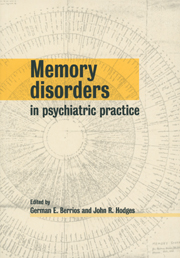Book contents
- Frontmatter
- Contents
- List of contributors
- Preface
- Part I
- Part II
- Part III
- 14 Paramnesias and delusions of memory
- 15 Déjà vu and jamais vu
- 16 Confabulations
- 17 Flashbulb and flashback memories
- 18 Functional memory complaints: hypochondria and disorganization
- 19 Dissociative amnesia: re-remembering traumatic memories
- 20 Recovered and false memories
- 21 The Ganser syndrome
- 22 Malingering and feigned memory disorders
- 23 Legal aspects of memory disorders
- Notes
- Index
19 - Dissociative amnesia: re-remembering traumatic memories
from Part III
Published online by Cambridge University Press: 06 January 2010
- Frontmatter
- Contents
- List of contributors
- Preface
- Part I
- Part II
- Part III
- 14 Paramnesias and delusions of memory
- 15 Déjà vu and jamais vu
- 16 Confabulations
- 17 Flashbulb and flashback memories
- 18 Functional memory complaints: hypochondria and disorganization
- 19 Dissociative amnesia: re-remembering traumatic memories
- 20 Recovered and false memories
- 21 The Ganser syndrome
- 22 Malingering and feigned memory disorders
- 23 Legal aspects of memory disorders
- Notes
- Index
Summary
Introduction
The amnesia phenomenon in patients with dissociative disorders currently represents one of the most intriguing areas in the study of psychiatric disorders and memory processes. The hallmark of the dissociative disorders is dissociative amnesia, which involves gaps in memory for personal history, both remote and recent. Dissociative amnesia intersects with the study of normal and traumatic memory, childhood sexual abuse, and suggestibility. The recent interest in memory and delayed recall of trauma has led to lively debates regarding the accuracy of memory in traumatized individuals, the veridicality of ‘recovered memories’, and the profound consequences that dissociated amnesia can have on family and social relationships leading to (delayed) prosecutions and other legal complications (Loftus, 1996; see the special issue of the International Journal of Clinical and Experimental Hypnosis, 1994; Whitfield, 1995; see special issue of the Journal of Psychiatry and Law, 1996; Bremner et al., 1996; Leavitt, 1997; Bremner & Narayan, 1998). Amnesia has recently become an important issue in the courtroom as well (Spiegel & Scheflin, 1994; Koss et al., 1995; Loftus, 1996; Pezdek & Banks, 1996; Scheflin & Brown, 1996; Brown et al., 1998; Scheflin & Spiegel, 1998). This chapter focuses on dissociative amnesia as defined by the DSM-IV classification, charting a wide course from both historical and conceptual issues that are related to dissociation to what is known about neurobiological correlates of the effects of trauma on memory. This chapter also reviews assessment, diagnosis, differential diagnosis and key principles of psychotherapy in the treatment of disociative amnesia.
Keywords
- Type
- Chapter
- Information
- Memory Disorders in Psychiatric Practice , pp. 400 - 431Publisher: Cambridge University PressPrint publication year: 2000

